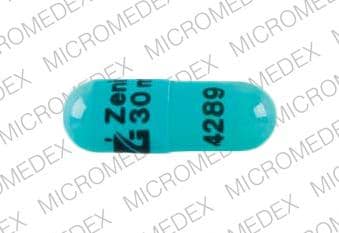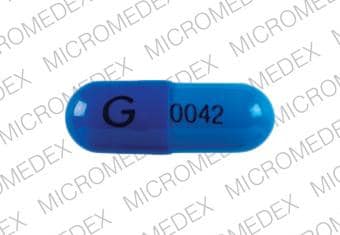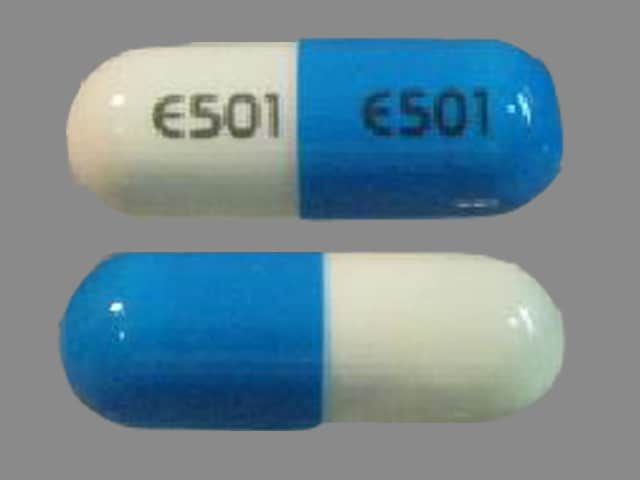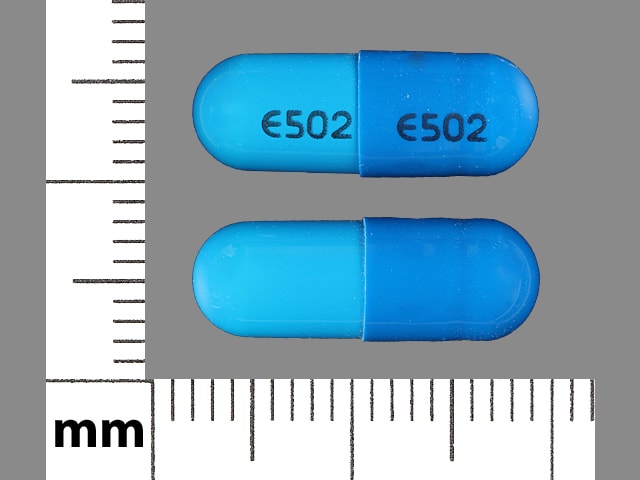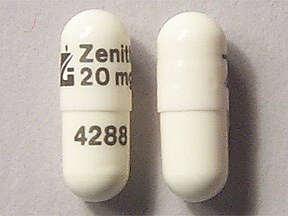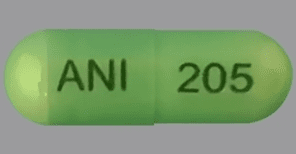Dosage Forms
Excipient information presented when available (limited, particularly for generics); consult specific product labeling.
Capsule, Oral, as hydrochloride:
Generic: 20 mg, 30 mg
Solution, Intravenous, as hydrochloride:
Cardene IV: 20 mg (200 mL); 40 mg (200 mL)
Generic: 2.5 mg/mL (10 mL)
Pharmacology
Mechanism of Action
Inhibits calcium ion from entering the “slow channels” or select voltage-sensitive areas of vascular smooth muscle and myocardium during depolarization, producing a relaxation of coronary vascular smooth muscle and coronary vasodilation; increases myocardial oxygen delivery in patients with vasospastic angina
Pharmacokinetics/Pharmacodynamics
Absorption
Oral: ~100%, but large first-pass effect
Distribution
Vd: 8.3 L/kg
Metabolism
Hepatic; extensive first-pass effect (saturable); major pathway is via cytochrome P450 isoenzyme CYP3A4, 2C8, and 2D6.
Excretion
Urine (oral: 60% as metabolites; IV: 49% as metabolites; <1% as unchanged drug); feces (oral: 35%; IV: 43%)
Clearance: Decreased in patients with hepatic impairment; may be decreased in patients with renal impairment
Onset of Action
IV: Within minutes (constant infusion); Oral: 0.5 to 2 hours
Peak effect: Immediate capsules: 1 to 2 hours; Sustained release capsules (at steady state): Sustained from 2 to 6 hours postdose; IV continuous infusion: 50% of the maximum effect is seen by 45 minutes
Time to Peak
Serum: Oral: Immediate release: 30 to 120 minutes (mean: 1 hour) ; Sustained release: 60 to 240 minutes
Duration of Action
IV: ≤8 hours. Upon discontinuation of continuous infusion, a 50% decrease in effect is seen in ~30 minutes with gradual discontinuing antihypertensive effects for ~50 hours.
Oral: Immediate release: ≤8 hours, Sustained release: 8 to 12 hours.
Half-Life Elimination
Follows dose-dependent (nonlinear) pharmacokinetics; “apparent” or calculated half-life is dependent upon serum concentrations.
Oral: Half-life over the first 8 hours after oral dosing is 2 to 4 hours; terminal half-life: 8.6 hours.
IV: After IV infusion, serum concentrations decrease tri-exponentially; alpha half-life: 3 minutes; beta half-life: 45 minutes; terminal half-life: 14 hours (Note: Terminal half-life can only be seen after long-term infusions).
Protein Binding
>95%
Use in Specific Populations
Special Populations: Renal Function Impairment
IV: Significantly lower systemic clearance and higher AUC in patients with mild to moderate renal impairment.
Oral:
Immediate release: Cmax and AUC were ~2-fold higher in patients with mild renal impairment.
Sustained release: Cmax and AUC were 2-fold to 3-fold higher in patients with moderate renal impairment.
Special Populations: Hepatic Function Impairment
In patients with severe hepatic impairment, plasma concentrations were elevated and the half-life was prolonged
Use: Labeled Indications
Angina: Management of chronic stable angina (oral immediate-release product only)
Hypertension: Management of hypertension (oral immediate- and sustained-release products and IV); parenteral only for short-term use when oral treatment is not feasible or not desirable
Guideline recommendations: The 2017 Guideline for the Prevention, Detection, Evaluation, and Management of High Blood Pressure in Adults recommends if monotherapy is warranted, in the absence of comorbidities (eg, cerebrovascular disease, chronic kidney disease, diabetes, heart failure, ischemic heart disease), that thiazide-like diuretics or dihydropyridine calcium channel blockers may be preferred options due to improved cardiovascular end points (eg, prevention of heart failure and stroke). ACE inhibitors and ARBs are also acceptable for monotherapy. Combination therapy may be required to achieve blood pressure goals and is initially preferred in patients at high risk (stage 2 hypertension or atherosclerotic cardiovascular disease [ASCVD] risk ≥10%) (ACC/AHA [Whelton 2017]).
Use: Off Label
Arterial hypertension in acute ischemic strokeyes
Based on the American Heart Association/American Stroke Association (AHA/ASA) guidelines for the Early Management of Patients with Acute Ischemic Stroke, nicardipine may be used to treat arterial hypertension (blood pressure >185/110 mm Hg) in acute ischemic stroke patients who are candidates for acute reperfusion therapy.
Additional Off-Label Uses
Control of blood pressure in patients with spontaneous intracranial hemorrhage; Perioperative hypertension; Subarachnoid hemorrhage associated cerebral vasospasm
Contraindications
Hypersensitivity to nicardipine or any component of the formulation; advanced aortic stenosis
Dosage and Administration
Dosing: Adult
Note: Cardene SR has been discontinued in the US for more than 1 year.
Angina: Immediate release: Oral: 20 mg 3 times daily; usual dosage: 20 to 40 mg 3 times daily (allow ≥3 days between dose increases)
Hypertension: Oral:
Immediate release: Initial: 20 mg 3 times daily; usual dosage: 20 to 40 mg 3 times daily (allow ≥3 days between dose increases)
Sustained release: Initial: 30 mg twice daily; usual dosage: 30 to 60 mg twice daily
Acute hypertension: IV: Initial: 5 mg/hour; may increase by 2.5 mg/hour every 5 minutes (for rapid titration) to every 15 minutes (for gradual titration) up to a maximum of 15 mg/hour; adjust infusion rate as needed to maintain desired response; in rapidly titrated patients, consider reduction to 3 mg/hour after response is achieved. Discontinue infusion if unacceptable hypotension or tachycardia occurs.
Arterial hypertension in acute ischemic stroke (off-label use [Jauch 2013]): IV:
Patient otherwise eligible for reperfusion treatment (eg, alteplase) except blood pressure (BP) >185/110 mm Hg: Initiate 5 mg/hour; titrate by 2.5 mg/hour at 5- to 15-minute intervals (maximum dose: 15 mg/hour). When goal BP obtained, adjust dose to maintain proper BP limits. If BP does not decline and remains >185/110 mm Hg, alteplase should not be administered.
Management of BP during and after reperfusion treatment (eg, alteplase) to maintain BP ≤180/105 mm Hg: If systolic BP >180 to 230 mm Hg or diastolic >105 to 120 mm Hg: Initiate 5 mg/hour; titrate by 2.5 mg/hour at 5- to 15-minute intervals (maximum dose: 15 mg/hour). If hypertension is refractory or diastolic BP >140 mm Hg, consider other IV antihypertensives (eg, nitroprusside).
Substitution for oral therapy (approximate equivalents):
20 mg every 8 hours oral, equivalent to 0.5 mg/hour IV infusion
30 mg every 8 hours oral, equivalent to 1.2 mg/hour IV infusion
40 mg every 8 hours oral, equivalent to 2.2 mg/hour IV infusion
Conversion to oral antihypertensive agent: Initiate oral antihypertensive at the same time that IV nicardipine is discontinued; if transitioning to oral nicardipine, start oral nicardipine 1 hour prior to IV discontinuation.
Dosing: Geriatric
Initiate at the low end of the dosage range. Specific guidelines for adjustment of nicardipine are not available, but careful monitoring is warranted and adjustment may be necessary.
Dosing: Pediatric
Hypertension: Note: Use should be reserved for acute severe hypertension: Limited data available: Infants, Children, and Adolescents: Continuous IV infusion: Bolus dose (optional): Initial: 30 mcg/kg, maximum dose: 2 mg/dose; followed by continuous infusion: Initial: 0.5 to 1 mcg/kg/minute; titrate dose according to blood pressure; rate of infusion may be increased every 15 to 30 minutes; maximum dose: 4 to 5 mcg/kg/minute (AAP [Flynn 2017]; Flynn 2000; Flynn 2001). In a retrospective analysis (n=29; mean age: 7.8 ± 6 years [range: 2 days to 17.9 years]), the mean initial dose was 0.8 ± 0.3 mcg/kg/minute (range: 0.2 to 1.3 mcg/kg/minute), the mean effective dose was 1.8 ± 1 mcg/kg/minute (range: 0.3 to 4 mcg/kg/minute); blood pressure was controlled within 2.7 ± 2.1 hours (range: 0.5 to 9 hours) after starting nicardipine continuous infusion (Flynn 2001).
Reconstitution
Parenteral:
Premixed bags: No further dilution needed.
Vial: Dilute 25 mg vial with 240 mL of compatible IV solution (eg, D5W, NS) to provide a 250 mL total volume solution and a final concentration of 0.1 mg/mL.
Administration
Oral: The total daily dose of immediate-release product may not automatically be equivalent to the daily sustained-release dose; use caution in converting. Administer without regards to meals; nicardipine sustained release administered with a meal may reduce the fluctuation in plasma levels. Do not chew or crush the sustained release formulation, swallow whole. Do not open or cut capsules.
IV:
Administer as a slow continuous infusion via central line or through a large peripheral vein. Peripheral venous irritation may be minimized by changing the site of infusion every 12 hours.
Premixed bags: Do not combine or run in the same line as other medications.
Storage
IV:
Premixed bags: Store at 20°C to 25°C (68°F to 77°F). Protect from light and excessive heat. Do not freeze.
Vials: Store at 20°C to 25°C (68°F to 77°F). Protect from light. Freezing does not adversely affect the product, but exposure to elevated temperatures should be avoided. Diluted solution (0.1 mg/mL) in D5W with KCl 40 mEq, D51/2NS, D5NS, D5W, NS, or 1/2NS is stable at room temperature for 24 hours in glass or PVC containers. Stability has also been demonstrated at room temperature at concentrations up to 0.5 mg/mL in PVC containers for 24 hours or in glass containers for up to 7 days (Baaske 1996).
Oral: Store at room temperature. Protect from light.
NiCARdipine Images
Drug Interactions
Alfuzosin: May enhance the hypotensive effect of Blood Pressure Lowering Agents. Monitor therapy
Alpha1-Blockers: May enhance the hypotensive effect of Calcium Channel Blockers. Monitor therapy
Amifostine: Blood Pressure Lowering Agents may enhance the hypotensive effect of Amifostine. Management: When amifostine is used at chemotherapy doses, blood pressure lowering medications should be withheld for 24 hours prior to amifostine administration. If blood pressure lowering therapy cannot be withheld, amifostine should not be administered. Consider therapy modification
Amphetamines: May diminish the antihypertensive effect of Antihypertensive Agents. Monitor therapy
Antifungal Agents (Azole Derivatives, Systemic): May enhance the adverse/toxic effect of Calcium Channel Blockers. Specifically, itraconazole may enhance the negative inotropic effects of verapamil or diltiazem. Antifungal Agents (Azole Derivatives, Systemic) may decrease the metabolism of Calcium Channel Blockers. Fluconazole and isavuconazonium likely exert weaker effects than other azoles and are addressed in separate monographs. Management: Concurrent use of felodipine or nisoldipine with itraconazole is specifically contraindicated. Frequent monitoring is warranted with any such combination; calcium channel blocker dose reductions may be required. Exceptions: Fluconazole; Isavuconazonium Sulfate. Consider therapy modification
Antipsychotic Agents (Second Generation [Atypical]): Blood Pressure Lowering Agents may enhance the hypotensive effect of Antipsychotic Agents (Second Generation [Atypical]). Monitor therapy
Aprepitant: May increase the serum concentration of CYP3A4 Substrates (High risk with Inhibitors). Monitor therapy
ARIPiprazole: CYP2D6 Inhibitors (Weak) may increase the serum concentration of ARIPiprazole. Management: Monitor for increased aripiprazole pharmacologic effects. Aripiprazole dose adjustments may or may not be required based on concomitant therapy and/or indication. Consult full interaction monograph for specific recommendations. Monitor therapy
Atosiban: Calcium Channel Blockers may enhance the adverse/toxic effect of Atosiban. Specifically, there may be an increased risk for pulmonary edema and/or dyspnea. Monitor therapy
Barbiturates: May increase the metabolism of Calcium Channel Blockers. Management: Monitor for decreased therapeutic effects of calcium channel blockers with concomitant barbiturate therapy. Calcium channel blocker dose adjustments may be necessary. Nimodipine Canadian labeling contraindicates concomitant use with phenobarbital. Monitor therapy
Barbiturates: May enhance the hypotensive effect of Blood Pressure Lowering Agents. Monitor therapy
Benperidol: May enhance the hypotensive effect of Blood Pressure Lowering Agents. Monitor therapy
Bosentan: May decrease the serum concentration of CYP3A4 Substrates (High risk with Inducers). Monitor therapy
Brigatinib: May diminish the antihypertensive effect of Antihypertensive Agents. Brigatinib may enhance the bradycardic effect of Antihypertensive Agents. Monitor therapy
Brimonidine (Topical): May enhance the hypotensive effect of Blood Pressure Lowering Agents. Monitor therapy
Bromperidol: Blood Pressure Lowering Agents may enhance the hypotensive effect of Bromperidol. Bromperidol may diminish the hypotensive effect of Blood Pressure Lowering Agents. Avoid combination
Calcium Channel Blockers (Nondihydropyridine): Calcium Channel Blockers (Dihydropyridine) may enhance the hypotensive effect of Calcium Channel Blockers (Nondihydropyridine). Calcium Channel Blockers (Nondihydropyridine) may increase the serum concentration of Calcium Channel Blockers (Dihydropyridine). Monitor therapy
Calcium Salts: May diminish the therapeutic effect of Calcium Channel Blockers. Monitor therapy
CarBAMazepine: May increase the metabolism of Calcium Channel Blockers (Dihydropyridine). Management: Consider calcium channel blocker (CCB) dose adjustments or alternative therapy in patients receiving concomitant carbamazepine. Nimodipine Canadian labeling contraindicates concurrent use with carbamazepine. Consider therapy modification
Carvedilol: NiCARdipine may enhance the hypotensive effect of Carvedilol. NiCARdipine may precipitate signs of heart failure in susceptible patients on Carvedilol NiCARdipine may increase the serum concentration of Carvedilol. Monitor therapy
Clofazimine: May increase the serum concentration of CYP3A4 Substrates (High risk with Inhibitors). Monitor therapy
Clopidogrel: Calcium Channel Blockers may diminish the therapeutic effect of Clopidogrel. Monitor therapy
Conivaptan: May increase the serum concentration of CYP3A4 Substrates (High risk with Inhibitors). Avoid combination
CycloSPORINE (Systemic): Calcium Channel Blockers (Dihydropyridine) may increase the serum concentration of CycloSPORINE (Systemic). CycloSPORINE (Systemic) may increase the serum concentration of Calcium Channel Blockers (Dihydropyridine). Monitor therapy
CYP3A4 Inducers (Moderate): May decrease the serum concentration of CYP3A4 Substrates (High risk with Inducers). Monitor therapy
CYP3A4 Inducers (Strong): May increase the metabolism of CYP3A4 Substrates (High risk with Inducers). Management: Consider an alternative for one of the interacting drugs. Some combinations may be specifically contraindicated. Consult appropriate manufacturer labeling. Consider therapy modification
CYP3A4 Inhibitors (Moderate): May decrease the metabolism of CYP3A4 Substrates (High risk with Inhibitors). Monitor therapy
CYP3A4 Inhibitors (Strong): May decrease the metabolism of CYP3A4 Substrates (High risk with Inhibitors). Consider therapy modification
Dabrafenib: May decrease the serum concentration of CYP3A4 Substrates (High risk with Inducers). Management: Seek alternatives to the CYP3A4 substrate when possible. If concomitant therapy cannot be avoided, monitor clinical effects of the substrate closely (particularly therapeutic effects). Consider therapy modification
Dapoxetine: May enhance the orthostatic hypotensive effect of Calcium Channel Blockers. Monitor therapy
Deferasirox: May decrease the serum concentration of CYP3A4 Substrates (High risk with Inducers). Monitor therapy
Dexmethylphenidate: May diminish the therapeutic effect of Antihypertensive Agents. Monitor therapy
Diazoxide: May enhance the hypotensive effect of Blood Pressure Lowering Agents. Monitor therapy
DULoxetine: Blood Pressure Lowering Agents may enhance the hypotensive effect of DULoxetine. Monitor therapy
Duvelisib: May increase the serum concentration of CYP3A4 Substrates (High risk with Inhibitors). Monitor therapy
Efavirenz: May decrease the serum concentration of Calcium Channel Blockers. Monitor therapy
Enzalutamide: May decrease the serum concentration of CYP3A4 Substrates (High risk with Inducers). Management: Concurrent use of enzalutamide with CYP3A4 substrates that have a narrow therapeutic index should be avoided. Use of enzalutamide and any other CYP3A4 substrate should be performed with caution and close monitoring. Consider therapy modification
Erdafitinib: May decrease the serum concentration of CYP3A4 Substrates (High risk with Inducers). Monitor therapy
Erdafitinib: May increase the serum concentration of CYP3A4 Substrates (High risk with Inhibitors). Monitor therapy
Erdafitinib: May increase the serum concentration of P-glycoprotein/ABCB1 Substrates. Monitor therapy
Fluconazole: May increase the serum concentration of Calcium Channel Blockers. Monitor therapy
Fosaprepitant: May increase the serum concentration of CYP3A4 Substrates (High risk with Inhibitors). Monitor therapy
Fosnetupitant: May increase the serum concentration of CYP3A4 Substrates (High risk with Inhibitors). Monitor therapy
Fosphenytoin: Calcium Channel Blockers may increase the serum concentration of Fosphenytoin. Management: Monitor for phenytoin toxicity with concomitant use of a calcium channel blocker (CCB) or decreased phenytoin effects with CCB discontinuation. Monitor for decreased CCB therapeutic effects. Nimodipine Canadian labeling contraindicates use with phenytoin. Consider therapy modification
Fusidic Acid (Systemic): May increase the serum concentration of CYP3A4 Substrates (High risk with Inhibitors). Avoid combination
Grapefruit Juice: May increase the serum concentration of NiCARdipine. Monitor therapy
Herbs (Hypertensive Properties): May diminish the antihypertensive effect of Antihypertensive Agents. Monitor therapy
Herbs (Hypotensive Properties): May enhance the hypotensive effect of Blood Pressure Lowering Agents. Monitor therapy
Hypotension-Associated Agents: Blood Pressure Lowering Agents may enhance the hypotensive effect of Hypotension-Associated Agents. Monitor therapy
Idelalisib: May increase the serum concentration of CYP3A4 Substrates (High risk with Inhibitors). Avoid combination
Ivosidenib: May decrease the serum concentration of CYP3A4 Substrates (High risk with Inducers). Monitor therapy
Larotrectinib: May increase the serum concentration of CYP3A4 Substrates (High risk with Inhibitors). Monitor therapy
Lasmiditan: May increase the serum concentration of P-glycoprotein/ABCB1 Substrates. Avoid combination
Levodopa-Containing Products: Blood Pressure Lowering Agents may enhance the hypotensive effect of Levodopa-Containing Products. Monitor therapy
Lorlatinib: May decrease the serum concentration of CYP3A4 Substrates (High risk with Inducers). Management: Avoid concurrent use of lorlatinib with any CYP3A4 substrates for which a minimal decrease in serum concentrations of the CYP3A4 substrate could lead to therapeutic failure and serious clinical consequences. Consider therapy modification
Lormetazepam: May enhance the hypotensive effect of Blood Pressure Lowering Agents. Monitor therapy
Macrolide Antibiotics: May decrease the metabolism of Calcium Channel Blockers. Management: Consider using a noninteracting macrolide. Felodipine Canadian labeling specifically recommends avoiding its use in combination with clarithromycin. Exceptions: Azithromycin (Systemic); Fidaxomicin; Roxithromycin; Spiramycin. Consider therapy modification
Magnesium Salts: Calcium Channel Blockers may enhance the adverse/toxic effect of Magnesium Salts. Magnesium Salts may enhance the hypotensive effect of Calcium Channel Blockers. Monitor therapy
Melatonin: May diminish the antihypertensive effect of Calcium Channel Blockers (Dihydropyridine). Monitor therapy
Methylphenidate: May diminish the antihypertensive effect of Antihypertensive Agents. Monitor therapy
MiFEPRIStone: May increase the serum concentration of CYP3A4 Substrates (High risk with Inhibitors). Management: Minimize doses of CYP3A4 substrates, and monitor for increased concentrations/toxicity, during and 2 weeks following treatment with mifepristone. Avoid cyclosporine, dihydroergotamine, ergotamine, fentanyl, pimozide, quinidine, sirolimus, and tacrolimus. Consider therapy modification
Mitotane: May decrease the serum concentration of CYP3A4 Substrates (High risk with Inducers). Management: Doses of CYP3A4 substrates may need to be adjusted substantially when used in patients being treated with mitotane. Consider therapy modification
Molsidomine: May enhance the hypotensive effect of Blood Pressure Lowering Agents. Monitor therapy
Naftopidil: May enhance the hypotensive effect of Blood Pressure Lowering Agents. Monitor therapy
Netupitant: May increase the serum concentration of CYP3A4 Substrates (High risk with Inhibitors). Monitor therapy
Neuromuscular-Blocking Agents (Nondepolarizing): Calcium Channel Blockers may enhance the neuromuscular-blocking effect of Neuromuscular-Blocking Agents (Nondepolarizing). Monitor therapy
Nicergoline: May enhance the hypotensive effect of Blood Pressure Lowering Agents. Monitor therapy
Nicorandil: May enhance the hypotensive effect of Blood Pressure Lowering Agents. Monitor therapy
Nitroprusside: Blood Pressure Lowering Agents may enhance the hypotensive effect of Nitroprusside. Monitor therapy
Obinutuzumab: May enhance the hypotensive effect of Blood Pressure Lowering Agents. Management: Consider temporarily withholding blood pressure lowering medications beginning 12 hours prior to obinutuzumab infusion and continuing until 1 hour after the end of the infusion. Consider therapy modification
Palbociclib: May increase the serum concentration of CYP3A4 Substrates (High risk with Inhibitors). Monitor therapy
Pentoxifylline: May enhance the hypotensive effect of Blood Pressure Lowering Agents. Monitor therapy
Perhexiline: CYP2D6 Inhibitors (Weak) may increase the serum concentration of Perhexiline. Monitor therapy
P-glycoprotein/ABCB1 Inducers: May decrease the serum concentration of P-glycoprotein/ABCB1 Substrates. P-glycoprotein inducers may also further limit the distribution of p-glycoprotein substrates to specific cells/tissues/organs where p-glycoprotein is present in large amounts (e.g., brain, T-lymphocytes, testes, etc.). Monitor therapy
P-glycoprotein/ABCB1 Inhibitors: May increase the serum concentration of P-glycoprotein/ABCB1 Substrates. P-glycoprotein inhibitors may also enhance the distribution of p-glycoprotein substrates to specific cells/tissues/organs where p-glycoprotein is present in large amounts (e.g., brain, T-lymphocytes, testes, etc.). Monitor therapy
Phenytoin: Calcium Channel Blockers may increase the serum concentration of Phenytoin. Phenytoin may decrease the serum concentration of Calcium Channel Blockers. Management: Avoid use of nimodipine or nifedipine with phenytoin. Monitor for phenytoin toxicity and/or decreased calcium channel blocker effects with any concurrent use. Consider therapy modification
Pholcodine: Blood Pressure Lowering Agents may enhance the hypotensive effect of Pholcodine. Monitor therapy
Phosphodiesterase 5 Inhibitors: May enhance the hypotensive effect of Blood Pressure Lowering Agents. Monitor therapy
Prostacyclin Analogues: May enhance the hypotensive effect of Blood Pressure Lowering Agents. Monitor therapy
Quinagolide: May enhance the hypotensive effect of Blood Pressure Lowering Agents. Monitor therapy
QuiNIDine: Calcium Channel Blockers (Dihydropyridine) may decrease the serum concentration of QuiNIDine. Calcium Channel Blockers (Dihydropyridine) may increase the serum concentration of QuiNIDine. QuiNIDine may increase the serum concentration of Calcium Channel Blockers (Dihydropyridine). Monitor therapy
Ranolazine: May increase the serum concentration of P-glycoprotein/ABCB1 Substrates. Monitor therapy
Rifamycin Derivatives: May decrease the serum concentration of Calcium Channel Blockers. This primarily affects oral forms of calcium channel blockers. Management: The labeling for some US and Canadian calcium channel blockers contraindicate use with rifampin, however recommendations vary. Consult appropriate labeling. Consider therapy modification
Sarilumab: May decrease the serum concentration of CYP3A4 Substrates (High risk with Inducers). Monitor therapy
Siltuximab: May decrease the serum concentration of CYP3A4 Substrates (High risk with Inducers). Monitor therapy
Simeprevir: May increase the serum concentration of CYP3A4 Substrates (High risk with Inhibitors). Monitor therapy
Sincalide: Drugs that Affect Gallbladder Function may diminish the therapeutic effect of Sincalide. Management: Consider discontinuing drugs that may affect gallbladder motility prior to the use of sincalide to stimulate gallbladder contraction. Consider therapy modification
Stiripentol: May increase the serum concentration of CYP3A4 Substrates (High risk with Inhibitors). Management: Use of stiripentol with CYP3A4 substrates that are considered to have a narrow therapeutic index should be avoided due to the increased risk for adverse effects and toxicity. Any CYP3A4 substrate used with stiripentol requires closer monitoring. Consider therapy modification
SUNItinib: NiCARdipine may increase the serum concentration of SUNItinib. Monitor therapy
Tacrolimus (Systemic): Calcium Channel Blockers (Dihydropyridine) may increase the serum concentration of Tacrolimus (Systemic). Monitor therapy
Tocilizumab: May decrease the serum concentration of CYP3A4 Substrates (High risk with Inducers). Monitor therapy
Yohimbine: May diminish the antihypertensive effect of Antihypertensive Agents. Monitor therapy
Test Interactions
May lead to false-negative aldosterone/renin ratio (ARR) (Funder 2016)
Adverse Reactions
1% to 10%:
Cardiovascular: Flushing (6% to 10%), pedal edema (dose related; 7% to 8%), exacerbation of angina pectoris (dose related; 6%), hypotension (IV 6%), palpitations (3% to 4%), tachycardia (1% to 4%), chest pain (IV 1%), extrasystoles (IV 1%), hemopericardium (IV 1%), hypertension (IV 1%), supraventricular tachycardia (IV 1%), edema (≤1%)
Central nervous system: Headache (6% to 15%), dizziness (4% to 7%), hypoesthesia (1%), intracranial hemorrhage (1%), pain (1%), somnolence (1%)
Dermatologic: Diaphoresis (1%), skin rash (≤1%)
Endocrine & metabolic: Hypokalemia (IV 1%)
Gastrointestinal: Nausea and vomiting (IV 5%), nausea (2%), dyspepsia (≤2%), abdominal pain (IV 1%), xerostomia (≤1%)
Genitourinary: Hematuria (1%)
Local: Injection site reaction (IV 1%), pain at injection site (IV 1%)
Neuromuscular & skeletal: Weakness (4% to 6%), myalgia (1%), paresthesia (1%)
<1%, postmarketing, and/or case reports: Abnormal dreams, abnormal hepatic function tests, abnormal vision, angina pectoris, anxiety, arthralgia, atrial fibrillation (not distinguishable from natural history of atherosclerotic vascular disease), atrioventricular block, atypical chest pain, blurred vision, cerebral ischemia (not distinguishable from natural history of atherosclerotic vascular disease), confusion, conjunctivitis, constipation, deep vein thrombophlebitis, depression, depression of ST segment on ECG, dyspnea, ear disease, ECG abnormal, fever, gingival hyperplasia, heart block (not distinguishable from natural history of atherosclerotic vascular disease), hot flash, hyperkinesia, hypersensitivity reaction, hypertonia, hypophosphatemia, impotence, infection, insomnia, inversion T wave on ECG, malaise, myocardial infarction (chronic therapy; may be due to disease progression), neck pain, nervousness, nocturia, orthostatic hypotension, oxygen saturation decreased (possible pulmonary shunting), parotitis, pericarditis (not distinguishable from natural history of atherosclerotic vascular disease), peripheral vascular disease, respiratory tract disease, rhinitis, sinus node dysfunction (chronic therapy; may be due to disease progression), sinusitis, sore throat, sustained tachycardia, syncope, thrombocytopenia, tinnitus, tremor, urinary frequency, ventricular extrasystoles, ventricular tachycardia, vertigo, vomiting
Warnings/Precautions
Concerns related to adverse effects:
- Angina/MI: Increased angina (frequency, duration, or severity) and/or MI has occurred. Reflex tachycardia may occur resulting in angina and/or MI in patients with obstructive coronary disease, especially in the absence of concurrent beta blockade.
- Hypotension/syncope: Symptomatic hypotension with or without syncope may rarely occur; blood pressure must be lowered at a rate appropriate for the patient's clinical condition. Avoid systemic hypotension in acute cerebral infarction or hemorrhage. Close monitoring of heart rate and blood pressure, especially during initial therapy and dosage titration, is required.
- Peripheral edema: A common side effect is peripheral edema (dose-dependent); occurs within 2 to 3 weeks of starting therapy.
- Tachycardia: May occur; close monitoring of heart rate is required.
Disease-related concerns:
- Aortic stenosis: Use with caution in patients with mild to moderate aortic stenosis; may reduce coronary perfusion resulting in ischemia. Use is contraindicated in patients with advanced aortic stenosis.
- Heart failure: Use in patients with heart failure (HF) or severe left ventricular dysfunction, particularly with concomitant beta-blockade, may experience worsened symptoms of HF due to mild negative inotropic effects of nicardipine. The ACC/AHA heart failure guidelines recommend to avoid use in patients with heart failure due to lack of benefit and/or worse outcomes with calcium channel blockers in general (ACC/AHA [Yancy 2013]).
- Hepatic impairment: Use with caution in patients with hepatic impairment or reduced hepatic blood flow. Consider lower starting dose and closely monitor response.
- Hypertrophic cardiomyopathy (HCM) with outflow tract obstruction: Use with caution in patients with HCM and outflow tract obstruction since reduction in afterload may worsen symptoms associated with this condition (ACC/AHA [Gersh 2011]).
- Renal impairment: Use with caution in patients with renal impairment. Increase dose cautiously in patients with renal impairment since clearance of nicardipine is diminished in this population.
Concurrent drug therapy issues:
- Drug-drug interactions: Potentially significant interactions may exist, requiring dose or frequency adjustment, additional monitoring, and/or selection of alternative therapy. Consult drug interactions database for more detailed information.
Dosage form specific issues:
- Propylene glycol: Some dosage forms may contain propylene glycol; large amounts are potentially toxic and have been associated hyperosmolality, lactic acidosis, seizures and respiratory depression; use caution (AAP 1997; Zar 2007).
Other warnings/precautions:
- Infusion sites: To minimize infusion site reactions, peripheral infusion sites (for IV therapy) should be changed every 12 hours; use of arteries or small peripheral veins should be avoided.
- Withdrawal: Abrupt withdrawal may cause rebound angina in patients with CAD.
Monitoring Parameters
Blood pressure, heart rate; consult individual institutional policies and procedures
Hypertension: The 2017 Guideline for the Prevention, Detection, Evaluation, and Management of High Blood Pressure in Adults (ACC/AHA [Whelton 2017]):
Confirmed hypertension and known CVD or 10-year atherosclerotic cardiovascular disease (ASCVD) risk ≥10%: Target blood pressure <130/80 mm Hg is recommended.
Confirmed hypertension without markers of increased ASCVD risk: Target blood pressure <130/80 mm Hg may be reasonable.
Diabetes and hypertension: The American Diabetes Association (ADA) guidelines (ADA 2019):
Patients 18 to 65 years of age, without ASCVD, and 10-year ASCVD risk <15%: Target blood pressure <140/90 mm Hg is recommended
Patients 18 to 65 years of age and known ASCVD or 10-year ASCVD risk >15%: Target blood pressure <130/80 mm Hg may be appropriate if it can be safely attained
Patients >65 years of age (healthy or complex/intermediate health): Target blood pressure <140/90 mm Hg is recommended
Patients >65 years of age (very complex/poor health): Target blood pressure <150/90 mm Hg is recommended
Pregnancy
Pregnancy Risk Factor
C
Pregnancy Considerations
Nicardipine has limited placental transfer following maternal oral and IV administration (Bartels 2007; Carbonne 1993; Matsumura 2014).
Nicardipine has been shown to decrease maternal blood pressure without significant changes on placental perfusion or fetal hemodynamics (Cornette 2016). Although effective for the treatment of hypertension in pregnancy, nicardipine may have an increased risk of adverse maternal events (eg, headache, nausea, tachycardia) in comparison to other agents (Nooij 2014). Cases of acute pulmonary edema have been reported following use as a tocolytic (Melis 2015).
Chronic maternal hypertension may increase the risk of birth defects, low birth weight, preterm delivery, stillbirth, and neonatal death. Actual fetal/neonatal risks may be related to duration and severity of maternal hypertension. Untreated hypertension may also increase the risks of adverse maternal outcomes, including gestational diabetes, myocardial infarction, preeclampsia, stroke, and delivery complications (ACOG 203 2019).
Calcium channel blockers may be used to treat hypertension in pregnant women; however, agents other than nicardipine are more commonly used for chronic hypertension (ACOG 203 2019; ESC [Regitz-Zagrosek 2018]). Females with preexisting hypertension may continue their medication during pregnancy unless contraindications exist (ESC [Regitz-Zagrosek 2018]). Nicardipine may be used as an alternative agent for the treatment of acute onset, severe hypertension in pregnant females (ACOG 203 2019; ACOG 767 2019).
Patient Education
What is this drug used for?
- It is used to treat high blood pressure.
- It is used to treat a type of long-term chest pain (stable angina) in some people.
Frequently reported side effects of this drug
- Flushing
- Headache
- Loss of strength and energy
- Vomiting
- Nausea
Other side effects of this drug: Talk with your doctor right away if you have any of these signs of:
- Severe dizziness
- Passing out
- Abnormal heartbeat
- Chest pain
- Fast heartbeat
- Shortness of breath
- Excessive weight gain
- Swelling of arms or legs
- Severe injection site pain, burning, edema, or irritation
- Signs of a significant reaction like wheezing; chest tightness; fever; itching; bad cough; blue skin color; seizures; or swelling of face, lips, tongue, or throat.
Note: This is not a comprehensive list of all side effects. Talk to your doctor if you have questions.
Consumer Information Use and Disclaimer: This information should not be used to decide whether or not to take this medicine or any other medicine. Only the healthcare provider has the knowledge and training to decide which medicines are right for a specific patient. This information does not endorse any medicine as safe, effective, or approved for treating any patient or health condition. This is only a brief summary of general information about this medicine. It does NOT include all information about the possible uses, directions, warnings, precautions, interactions, adverse effects, or risks that may apply to this medicine. This information is not specific medical advice and does not replace information you receive from the healthcare provider. You must talk with the healthcare provider for complete information about the risks and benefits of using this medicine.
